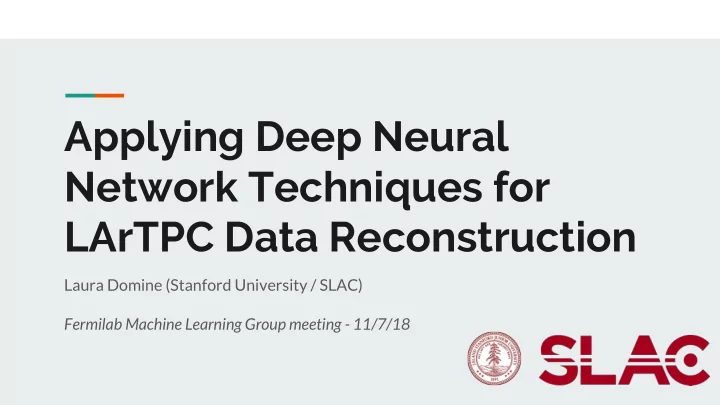

Applying Deep Neural Network Techniques for LArTPC Data Reconstruction Laura Domine (Stanford University / SLAC) Fermilab Machine Learning Group meeting - 11/7/18
Plan 1. LArTPC & Deep Learning 2. Examples of applications: UResNet & PPN networks 3. Sparse convolutions
LArTPC & Deep Learning
Liquid Argon Time Projection Chamber (LArTPC) Neutrino detectors Ex: MicroBooNE @ Fermilab, 150 tons 2D or 3D data Bigger and bigger! (DUNE) Neutrinos.
Deep Neural Networks (DNN) & Computer Vision Picture from Martin Görner
Deep Neural Networks (DNN) & Computer Vision Object detection & classification Semantic segmentation
Towards a full reconstruction chain with DNN Currently: Lots of heuristic algorithms ● Goal: Replace them with a set of DNN ● algorithms which ideally will Run faster ○ Have a better ○ performance
Towards a full reconstruction chain with DNN Steps: 1. Point detection (track edge) Non-contractual picture - Actual product may differ
Towards a full reconstruction chain with DNN Steps: 1. Point detection (track edge) PPN Non-contractual picture - Actual product may differ
Towards a full reconstruction chain with DNN Steps: 1. Point detection (track edge) PPN 2. Pixel-wise labeling (particle track vs electromagnetic shower) Non-contractual picture - Actual product may differ
Towards a full reconstruction chain with DNN Steps: 1. Point detection (track edge) PPN 2. Pixel-wise labeling (particle track vs electromagnetic shower) UResNet Non-contractual picture - Actual product may differ
Towards a full reconstruction chain with DNN Steps: 1. Point detection (track edge) PPN 2. Pixel-wise labeling (particle track vs electromagnetic shower) UResNet 3. Clustering of energy deposits and instance segmentation Non-contractual picture - Actual product may differ
Towards a full reconstruction chain with DNN Steps: 1. Point detection (track edge) PPN 2. Pixel-wise labeling (particle track vs electromagnetic shower) UResNet 3. Clustering of energy deposits and instance segmentation Work in progress! Non-contractual picture - Actual product may differ
Towards a full reconstruction chain with DNN Steps: 1. Point detection (track edge) PPN 2. Pixel-wise labeling (particle track vs electromagnetic shower) UResNet 3. Clustering of energy deposits and instance segmentation Work in progress! 4. Particle identification and energy estimate 5. Hierarchical reconstruction Non-contractual picture - Actual product may differ
Examples of applications: UResNet and PPN networks
Semantic Segmentation: UResNet
Semantic Segmentation: UResNet Decoder Encoder Residual connections
Semantic Segmentation: UResNet Data Physicist’s label Network’s output A Deep Neural Network for Pixel-Level Electromagnetic Particle Identification in the MicroBooNE Liquid Argon Time Projection Chamber. https://arxiv.org/abs/1808.07269
Point-finding: PPN Inspired by Faster-RCNN architecture Region Proposal Network detects ● regions of interest Replace regions with points = ● Pixel Proposal Network (PPN) Why not Mask-RCNN? Computations expensive ○ Our features topology is ○ different (track, shower)
PPN proposals
PPN needs post-processing + scores…!
PPN needs post-processing Option 1: DBSCAN Density estimation algorithm ● No prior on the number of clusters. ● Option 2: NMS (Non-Maximal Suppression) Popular post-processing method for object ● detection Order by score and prune boxes with too much ● overlap
ZOOM NB: independently of DBSCAN vs NMS, these plots also benefit from debugged ground truth pixels position.
Together
6mm/voxel UResNet + PPN 3D Analysis 24cm 2 4 c m
6mm/voxel UResNet + PPN 3D Analysis 24cm 24cm
Sparse UResNet
How do we handle sparse data? Sparse Dense
Naive approach Input: dense 3D matrix of energy deposits. Crop your data ● Run the network on small cropped images ● Stitch together results ● Many cropping algorithms possible Compromises to make: Maximize the number of overlapping boxes (accuracy) ● Minimize the number of boxes (computation time) ●
Sparse Convolutions Many possible definitions and implementations of ‘sparse convolutions’... Submanifold Sparse Convolutions : https://github.com/facebookresearch/SparseConvNet Submanifold? “input data with lower effective dimension than the space in which it lives” Ex: 1D curve in 2+D space, 2D surface in 3+D space Our case: the worst! 1D curve in 3D space ...
Sparse Convolutions Submanifold Sparse Convolutions : https://github.com/facebookresearch/SparseConvNet 3D Semantic Segmentation with Submanifold Sparse Convolutional Networks
Sparse UResNet Input: list of points coordinates and their features (e.g. energy deposition) With UResNet architecture: >99.9% accuracy in 3D ● Faster training (less computations!): only a few hours ● Much lower memory usage ● Example in larcv-viewer
Summary Extract interesting / useful features with deep neural networks: ● Points of interest with PPN ○ Pixel-wise classification track vs shower with UResNet ○ Currently working on clustering and instance segmentation ● (particle type, particle instances) Sparse techniques are very exciting! ● Join DeepLearnPhysics group! Technical discussion on ML applied to experimental physics data ● Data + code sharing for reproducibility ●
Thank you!
Backup slides
PPN Loss: details
Recommend
More recommend